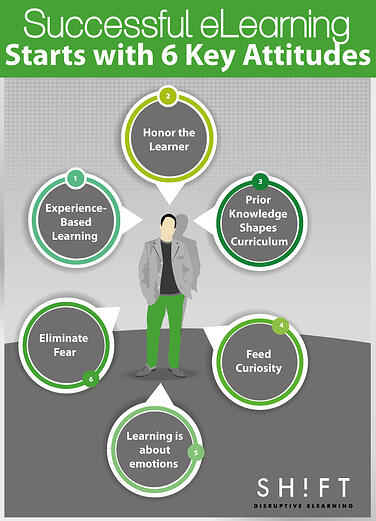In the world of education theory, writers and researchers talk a great deal about learning dispositions, those tendecies of great thinkers and learning that help them learn more effectively. In essence, a learner disposition is the attitude or mindset the student brings to an educational environment to make him or her more likely to retain the new information. Kratz defines dispositions as “relatively enduring habits of mind or characteristic ways of responding to experience across types of situations.”
 By honoring and reinforcing those attitudes, you can develop more effective courses. eLearning courses become more student-centered and therefore, more effective. Without those positive attitudes, students have little chance of learning proficiently, if at all.
By honoring and reinforcing those attitudes, you can develop more effective courses. eLearning courses become more student-centered and therefore, more effective. Without those positive attitudes, students have little chance of learning proficiently, if at all.
Based on studies on learner-centered education, the following six dispositions have been identified as centrally important to increase student motivation and achievement:
Attitude #1: Experience-Based Learning
Or, in other words, learning by doing. Learning arises through experience, activity and practical application. For the span of humankind, we have learned by doing, through trial and error and by applying our skills and knowledge to new situations to see the outcome. When people learn by doing, they become energized, they stick with the content, and they learn more.
In eLearning specifically, simulations and games allow learners to apply their knowledge to see the outcome; and these work best when the learner can adjust variables to see how they affect outcomes. Using real life scenarios, case studies and stories also contributes to experience-based education because it feeds into our human tendency to learn through storytelling. Through these instructional techniques, students can learn from expert practitioners or other employees who have worked through complex situations already.
Attitude #2: Honor the Learner
eLearning courses often place the focus on the instructor or on the content. However, the focus should go on the learners and ensuring they walk away having attained the key concepts. Without doubt, the first step when planning an eLearning course is considering the learner's qualities and dispositions.
Courses can honor the learner by presenting information in different ways to address the variety of strengths and weaknesses of all learners. They should also have multiple opportunities for learners to show proficiency and demonstrate their learning.
Attitude #3: Prior Knowledge Shapes Curriculum
Best practices in K-12 education call for teachers to conduct formative assessments to determine what students already know about a topic. Those pre-assessments then shape the learning going forward. If students have extensive knowledge about a topic, the teacher may delve deeper into more complex aspects of that curriculum. If students show no knowledge, the course may have to become more elementary.
The take away for eLearning is to know what your learner knows — or doesn't know — in order to shape curriculum the students can access and will provide the greatest learning benefit. Learner-centered eLearning courses must view the content through the learners' eyes, understanding what assumptions and prior knowledge exists in their heads.
Attitude #4: Feed Curiosity
We are a naturally curious species, always looking behind the horizon for new adventures and experiences. Curiosity drives innovation and learning, pushing us to find new answers when confronted with challenging questions or complex problems. It makes our minds active instead of passive. The main attitude that can be created is that of desire to go on learning, to continue through the course with motivation.
eLearning experiences should capitalize on our curious natures through brainteasers, complex scenarios, ethical dilemmas, and challenging/thought-provoking questions that ask learners to explore and think about information in new ways. Try introducing a topic with a demonstration or incorporating activities that stimulate multiple senses.
Attitude #5: Learning is about emotions
If we are a curious species, we are also an emotional species. We engage with new ideas and concepts much more readily when they also feed into our emotions. Emotional and personal content allows the learner to connect with the subject matter on a deeper, more intrinsic level. Where emotion is involved, the effect upon learning is drastically intensified.
Moreover, eLearning course should try to generate positive attitudes (more enthusiastic participating, more interest and openness.) The more positive learners feel about the material, the more motivation they will have to learn it.
Appeal to their emotions by having them put themselves in the shoes of someone making a decision. You can also activate learner's emotions through:
-
Surprising content and facts;
-
Controversy and suspense;
-
Lessons that evoke memories;
-
Compelling stories;
-
Media that evokes emotional responses.
Attitude #6: Eliminate Fear
So far, all the learner attitudes encourage course designers to challenge learners. Those challenges must come without fear, though. Fear of making mistakes can inhibit the learning process. Create safe spaces for learners to engage their emotions, become curious thinkers and even experience fail without fear.
Keep your eLearning courses student-centered by honoring the six key learner attitudes that will lead to success. These kinds of dispositions to learn will support learning for a lifetime, no matter the topic.









